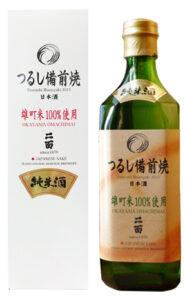This sake brewery was founded in 1870. They use rice varieties Omachi, Asahi and Akebono, of which at least 90% is grown in Okayama Prefecture. Water for their sake brewery is taken from the nearby Ashimori River, which is the largest natural home of fireflies around Okayama. Fireflies dance around the river mainly in the summer months and are proof of the purity of the river water. The master brewer – toji – is Mr. Fuminobu Itano, who belongs to the Bicchu Brewers’ Guild. This guild is known for using traditional brewing methods even today, when sake breweries are using more and more machines. Regarding the traditional production, Mr. Itano manages to produce the same quality of sake every year. Their main product line is classical sake. If you speak Japanese, you can visit their site.
Futamo Genshu
Undiluted sake Futamo Genshu excels in its rich and full taste, despite its light and delicate aroma.
Thanks to its higher alcohol content – 19% – it is suitable for consumption as an aperitif or in mixed drinks. Due to its distinctive taste, it can be served heated up to 40°C or as part of hot drinks.
Kinojo Junmai
Kinojo Junmai is a fresh dry sake that uses Akebono rice, which is exclusively from growers in Okayama Prefecture. It is ground to 69%, which is unusually low for the Junmai category. Even so, this variety conveys its taste to the resulting sake.
We recommend serving it chilled or paired with dishes such as tempura or fish sashimi with a delicate taste.
Kinojo Junmai Ginjo
This Junmai Ginjo sake excels in its more pronounced aroma when using Akebono rice, which is ground to 60%, and gives this sake soft rice tones. It is beautifully fruity in aroma and taste. The combination of the local Akebono variety and the traditional brewing process represented by a member of the Bicchu Brewers’ Guild, Mr Fuminobu Itano, is a prime example of the local sake style, which reflects the area where it was brewed.
We recommend serving this sake chilled. For food-pairing, try the advice of Mrs. Keiko Itano, who likes to pair this sake with Sukiyaki or Yakitori chicken skewers, which are grilled using only salt and pepper.
Futamo Omachi tsurushi bizen-yaki junmai
The Itano Shuzo Honten sake brewery was inspired by history for brewing of this sake. In the past, it was said that miso paste or rice vinegar were tastier, when they immersed a carafe of Bizen ceramics in a fermentation vat during production. Therefore, this technique is also used in the production of this sake. A carafe is immersed in a fermentation vat with junmai-type sake for a predetermined time. This unglazed ceramic gives the sake a delicate taste with umami tones.
Omachi rice is used in the production, which is milled to 65%. This rice, by its own taste, supports the earthiness of this sake.
We recommend serving chilled or at room temperature. If served with food, it is well paired with the Japanese dish Buta Kakuni – cooked pieces of pork belly. Unusually, however, it is also suitable for leaf salads with less pronounced dressing or chocolate.




